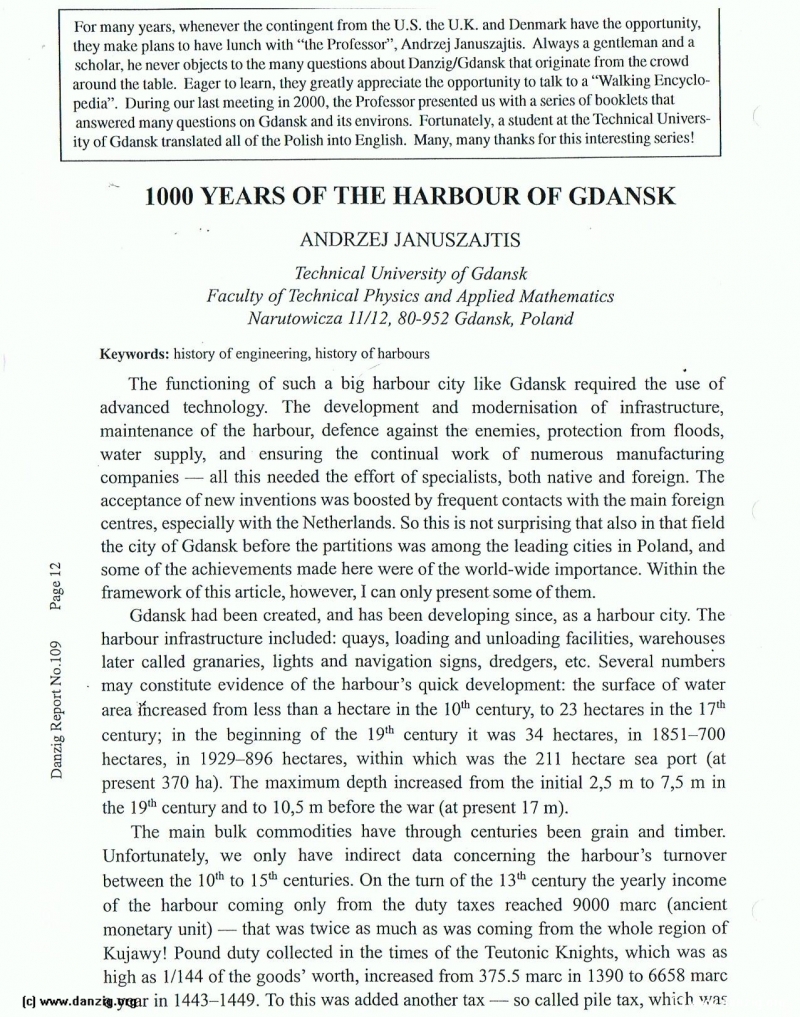
For many years, whenever the contingent from the U.S. the U.K. and I)enmark have the opportunity, they make plans to have lunch with “the Professor”, Andriej Januszajtis. Always a gentleman and a scholar, he never objects to the many questions about Danzig / Gdansk that originate from the crowd around the table. Eager to learn, they greatly appreciate the opportunity to talk to a “Walking Encyclopedia”. During our last meeting in 2000, the Professor presented us with a series of booklets that answered many questions on (idansk and its environs. Fortunately, a student at the Technical University of Gdansk translated all of the Polish into English. Many, many thanks for this interesting series!
1000 YEARS OF THE HARBOUR OF GDANSK
ANDRZEJ JANUSZAJTIS
Technical University of Gdansk
Faculty of Technical Physics and Applied Mathematics
Narutowicza 11/12, 80-952 Gdansk, Poland
Keywords: history of engineering, history of harbours
The functioning of such a big harbour city like Gdansk required the use of advanced technology. The development and modernisation of infrastructure, maintenance of the harbour, defence against the enemies, protection from floods, water supply, and ensuring the continual work of numerous manufacturing companies — all this needed the effort of specialists, both native and foreign. The acceptance of new inventions was boosted by frequent contacts with the main foreign centres, especially with the Netherlands. So this is not surprising that also in that field the city of Gdansk before the partitions was among the leading cities in Poland, and some of the achievements made here were of the world-wide importance. Within the framework of this article, however, I can only present some of them.
Gdansk had been created, and has been developing since, as a harbour city. The harbour infrastructure included: quays, loading and unloading facilities, warehouses later called granaries, lights and navigation signs, dredgers, etc. Several numbers may constitute evidence of the harbour’s quick development: the surface of water area rncreased from less than a hectare in the 10th century, to 23 hectares in the 17th century; in the beginning of the 19th century it was 34 hectares, in 1851—700 hectares, in 1929—896 hectares, within which was the 211 hectare sea port (at present 370 ha). The maximum depth increased from the initial 2,5 m to 7,5 rn in the 9 century and to 10,5 m before the war (at present 17 m).
The main bulk commodities have through centuries been grain and timber. Unfortunately, we only have indirect data concerning the harbour’s turnover between the I 0Ih to 1 5th centuries. On the turn of the 1 3th century the yearly income of the harbour coming only from the duty taxes reached 9000 marc (ancient monetary unit) — that was twice as much as was coming from the whole region of Kujawy! Pound duty collected in the times of the Teutonic Knights, which was as high as 1/144 of the goods’ worth, increased from 375.5 marc in 1390 to 6658 marc a year in 1443—1449. To this was added another tax — so called pile tax, which was
Danzig Report Vol. 1 - Nr. 109 - October - November - December - 2000, Page 18.
Hits: 3730
Added: 28/07/2015
Copyright: 2025 Danzig.org

